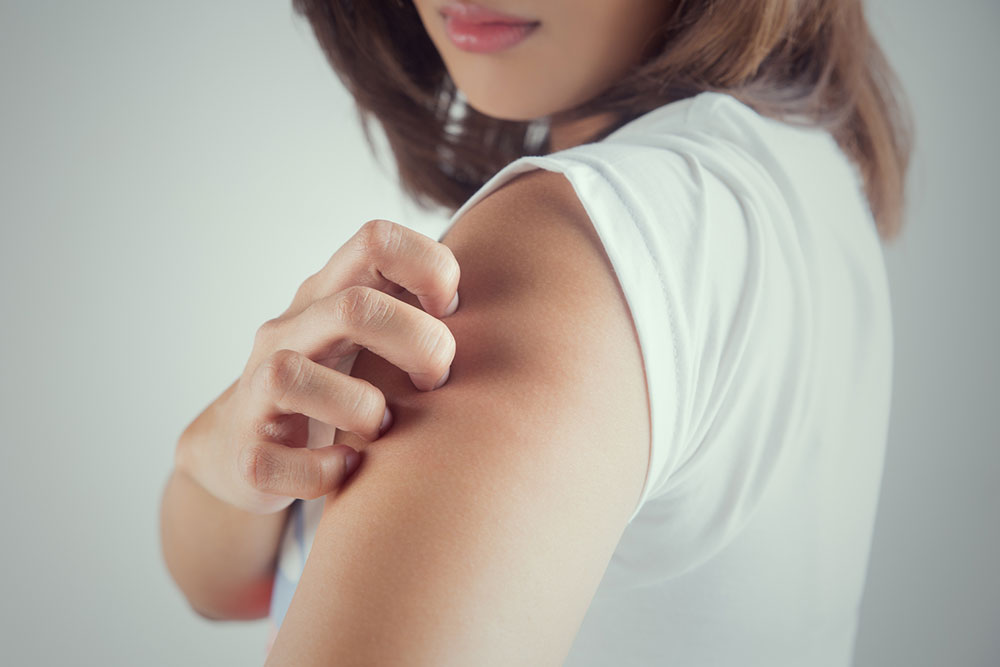Treatment Options for Different Types of Skin Rashes
A noticeable change in the color or texture of the skin is known as a rash. Your skin might become bumpy, itchy, scaly, or maybe irritated. There are various types of skin rashes one can suffer from, and so, here is a close look at most types. This article will help you identify the rash or know when to consult a doctor so that you can get treated effectively. Many rashes can be managed at home as well.
Flea Bites
This is one such type of skin rash that is generally located in clusters mainly on the feet and lower legs.

Fifth disease
Rashes in this disease usually are accompanied by low fever, sore throat, headache, fatigue, runny nose, nausea, and diarrhea. This type of skin rash is more common in children, and they manifest as a bright red, round rash on the cheeks. One can also find a lacy patterned rash on legs, arms, and upper body.
Rosacea
This is one such chronic skin disease which follows a cycle of relapse and fading.
Impetigo
This is more commonly observed in children and babies. To identify skin rash due to this condition look for rashes near the chin, mouth, and nose. The rash usually forms a honey-colored crust on the skin. Fluid-filled blisters can also accompany the rash.
Ringworm
They are scaly rashes in a circular shape with a raised border. Usually, the skin in the middle of the ring looks healthy and clear, while the edges may keep spreading outward. This type of rash is accompanied by lots of itchiness.
Contact Dermatitis
The rash related to this appear within hours after the skin gets in contact with an allergen. To identify skin rash of this kind, notice if your skin has become scaly, raw, red and itchy. One can observe the visible borders that appear throughout all the locations which were in contact with the allergen.
Allergic Eczema
This rash resembles a burn closely. It is often seen on forearms and hands. The skin becomes red, itchy, raw or scaly. There are also blisters that ooze, weep or are crusty.
Hand, foot, and mouth disease
This mostly affects children under the age of 5. Raised or flat red spots can be found on the soles of the feet and palms of the hand. Sometimes, the spots might also manifest in the genital area or the buttocks.
Diaper rash
They are mainly located in areas that are in direct contact with the diaper. The skin looks irritated, wet and red.
Psoriasis
This is defined by silvery, scaly, sharply defined skin patches. They usually manifest on the knees, elbows, lower back, and scalp. They could be asymptomatic or itchy.
Chickenpox
It is easy to identify skin rash of this type as it comes in clusters of red, itchy, fluid-filled blisters. They are also accompanied by body aches, fever, loss of appetite, and sore throat.
Shingles
This skin rash can be very painful. The rash may tingle, burn, and itch. It comes with a fluid-filled blister that breaks easily. The rash manifests in a typical linear pattern most commonly observed on the torso.
Treatment of rashes at home
You can easily treat most of the contact rashes, however, that depends on its underlying cause. You can follow the guideline listed below to ease pain and speed up the healing process –
- Try using gentle or mild cleansers instead of scented bar soaps
- Use warm water for washing your hair and skin
- Pat on the rash instead of rubbing
- Make sure that the rash can breathe. Avoid covering it with any kind of clothing
- You can apply moisturizing unscented lotion over the rash
- Avoid scratching the rash as it will only worsen the situation
- You can apply over-the-counter creams, such as hydrocortisone on the affected area if the rash is causing discomfort. Calamine lotion is also known to help relieve rashes occurring from chickenpox, poison oak or poison ivy.
- You can go for an oatmeal bath, as it can give you relief from the itchiness that comes from psoriasis or eczema.
- If you have a lot of dandruff along with rash, then make sure that you wash your scalp and hair regularly with a medicated dandruff shampoo
Though most rashes are easily treatable, care has to be taken when dealing with them. With the right precautions, you can manage most rashes. However, you should immediately contact your healthcare provider if the condition worsens. Make sure that you give your rash sufficient time to heal and do not apply cosmetics to the affected area for some time after the rash has healed.

